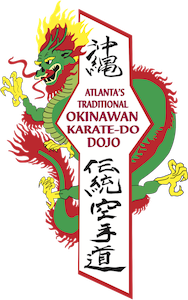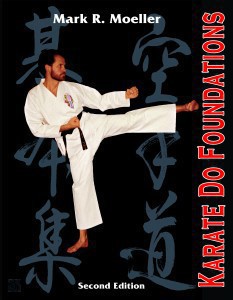The Importance of Kata and How to Practice
From Karate-do Foundations, by Mark Moeller:
The practice of kata is the culmination of a practitioner’s individual training. A significant advantage of kata is that techniques can be practiced full force without the risk of injuring partners. Kata practice also develops fighting spirit and fighting rhythms. It simulates an actual fighting situation because it allows the practitioner to feel and experience the coordinated movements at full speed and full power without having to “pull” the technique to avoid injuring one’s training partner. There are many techniques in kata that are simply too dangerous to practice with another person. Another advantage is that one can practice kata alone when partners are not available.
A key idea when performing kata is to imagine that one is actually fighting one or more opponents as the kata is executed. This visualization transforms the kata from a series of strictly mechanical movements into a meaningful and realistic training aid. One of the highest compliments one can receive after performing a kata is that it looked like an actual fight. This is the goal to strive for in kata practice.
When done correctly, kata practice also teaches the development of a clear mind. At the highest levels of practice, practitioners often feel that their bodies are performing the kata without the direction or interference of the conscious mind. The kata is simply expressed through them. This mental state is referred to as mushin or “no mind”.
In an actual encounter, mushin is the mental state the practitioner strives to maintain because it enables the practitioner to respond instinctively without the delay or interference of conscious thought. Not only is this type of response quicker, it is also more effective because it draws on the intuitive knowledge of the entire being. This response without conscious thought is the realization of body knowledge. Kata practice teaches the practitioner how to enter into this mental state at will, thereby enhancing the practitioner’s ability to enter this mental state in an actual encounter. This is one of the reasons why traditional Okinawan Karate-do teachers have always emphasized kata practice.
In order to get the maximum benefit from kata, one should work separately on “The Seven Ways to Practice Kata”. The Seven Ways are: Form, Power, Speed, Eye Contact, Breathing, Fighting Rhythms, and Kiai. Each of these will improve one’s ability to execute the techniques in the kata in the most effective manner. By focusing on only one Way at a time, one will improve more quickly than if one is trying to concentrate on a number of Ways at the same time. As each of the different Ways is isolated and improved, a natural integration occurs creating a synergistic effect which makes the techniques substantially more effective.
The Seven Ways to Practice Kata
1. Form
a. Form is the first Way that one learns and is the most important. If one executes techniques with correct form, one is doing them in the strongest and most efficient (and therefore quickest) manner. Form is something that one is continually refining and perfecting. One never masters a particular technique. Rather, one continually improves and moves closer to perfection.
b. Poor form causes a “corruption” of the principles. When one corrupts a principle, one loses power and effectiveness proportionately. For example, if one’s elbow is not behind the fist when punching (and the elbow is allowed to flare out), one will lose power and strength. For every incremental degree that the elbow moves out to the side when punching, one loses more and more power. This is true for all the principles and is why one must continually strive to execute techniques with the correct form.
c. To improve form, practice the kata very slowly and concentrate on doing each technique with the proper checkpoints and correct application of principles. At the same time, visualize yourself doing the technique perfectly.
2. Power
a. One key to increasing power is to utilize more of the body. The legs, hips, shoulders, and arms (for punches) must work together to produce the maximum amount of force. The correct timing and sequence of the motions comprising the techniques are critical.
b. To improve power, concentrate on doing each technique as forcefully as possible with the correct sequence of body parts. It helps to pause slightly between each technique because this allows time to concentrate on generating the greatest amount of power.
3. Speed
a. Relaxation equals speed. One of the biggest barriers to increasing speed is excessive (and unnecessary) tension in the muscles. Unfortunately, tension often increases when one trys to do a motion faster. This is because the “trying” gets in the way of the “doing”. Less effort is better than more effort when it comes to increasing speed.
b. To improve speed, concentrate on staying “loose” and relaxed while avoiding trying too hard. Do not worry about the amount of force generated by the techniques. The techniques should be light and quick when practiced for speed.
4. Eye Contact
a. Eye contact emphasizes the visualization of opponents as the kata is executed. Without this visualization, kata practice cannot simulate the feeling of an actual fight and practice will not be as beneficial as it could be.
b. To improve and practice eye contact, look sharply on each turn and actually “see” an opponent in the mind’s eye. Try to feel each block deflecting an attack and each strike making contact with an opponent.
5. Breathing
a. The idea is to coordinate breathing from the diaphragm with the execution of techniques. This helps to control one’s respiration rate and may be used to augment power. To breathe from the diaphragm when inhaling, the lower belly (and not the chest) should expand first as air is brought into the lungs. To breathe from the diaphragm when exhaling, the lower belly should pull inwards to force the air out of the lungs.
b. To practice coordinating breathing with the execution of techniques, inhale on the blocking techniques and exhale on striking techniques. The exhales should be short, focused, bursts of air done with the teeth together. This is sometimes described as “spitting” out the air.
6. Fighting Rhythms
a. The timing and rhythm of attacks and counters in an actual fight is erratic. It is therefore important to train oneself to adjust to varying speeds. All blocking techniques are ineffective if they are done too fast or too slow. The timing needs to match exactly the speed of the attack.
b. To practice kata for the development of fighting rhythms, break the kata down into series that seem logically connected. Each series should represent an encounter with one or more opponents. Try to simulate the rhythm of an actual fight by varying the speed and pausing between each series. If kata is not practiced for Fighting Rhythms, the kata may become blurred and a purely mechanical repetition of choreographed movements.
7. Kiai
a. Kiai means to unite the spirit or internal energies. The idea is to coordinate all of the entire being’s energy into the execution of the techniques. A kiai is frequently done by forcing the air out of the diaphragm while executing a punch or kick. The forced exhale is what produces the loud shout one normally associates with a kiai.
b. When done properly, a kiai unites one’s internal energies with the physical energy produced by the contraction of the muscle. This makes the techniques incredibly powerful.
c. To practice with kiai, imagine all of the energy of the entire being is being unified and projected outward as the technique is executed. There should be a feeling of intense focus. It helps to add the loud shout to some of the punches, kicks, or strikes in the kata.

